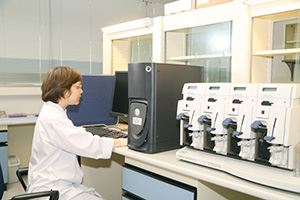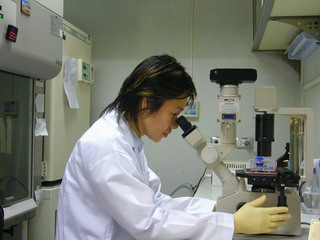Home | Research Focus | Research Activities |Publications | Staff | Contact Information |
Studies on Genetic Alteration in Cancers Prevalent in Thailand
The central goal of the project is to gain an understanding of the molecular changes that will lead to the development of various types of cancer. Tumors of the esophagus, liver (hepatocellular carcinoma, cholangiocarconoma), hematopoietic system (malignant lymphoma) and cervix are becoming prevalent in Thailand, with geographical variations in their occurrence probably reflecting differences in etiology. The collaborative studies between the laboratory and the International agency for Research on Cancer (IARC) will examine the frequency of mutations in cancer cases (particularly in cell control genes), selected on the basis of pathology and clinical stage. The aim is to examine in properly planned epidemiological studies the role of genetic alterations in the etiology, pathogenesis, diagnosis and prognosis of these cancers
Nasopharyngeal carcinoma (NPC)
Nasopharyngeal carcinoma (NPC) is an endemic cancer with a male to female ratio about 2-3:1. The high endemic areas include Southern China, Greenland and Alaska . The annual incidence of NPC varies from less than 1 per 100,000 population in non-endemic area to 19 cases per 100,000 population in highly endemic areas. Thailand has an incidence rate of 5 cases per 100,000 population with this cancer being one of the ten most prevalent in males and particularly in the Chinese ethnic population.
Epstein Barr Virus (EBV) infections, dietary and environmental factors e.g. consumption of salted fish and meat have been found to be associated with the disease. Occupational hazards including exposure to formaldehyde, dust and certain aromatic hydrocarbons have been determined as possible risk factors for NPC. Genetic factors and alcohol consumption have also been determined as possible risk factors for this type of cancer. However, the molecular events leading to the development of the tumor are still not well understood.
In this study, we analysed p53 mutations from NPC patients in Chiang Mai and Bangkok provinces to determine whether they correlated with the incidence of NPC.
Esophageal Cancer
Cancer of esophagus can be classified into squamous cell carcinoma (SCC) and adenoma (ADC). It ranks among one of the ten most frequent cancers in the world and is prevalent in developing countries.
It has been shown that the analysis of genetic alterations, particularly of p53 gene mutations in ADC and SCC are different in molecular level. Such differences reflect not only the involvement of distinct causative agents and mutational mechanisms but also the existence of distinct cell type specific pathways towards the expression of malignant phenotypes and tumor progression. It is believed that exposure to both tobacco and alcohol is associated with p53 in SCC whereas in ADC, p53 may result from the complex interplay between exogenous factors and endogenous biological processes.
In Thailand, the occurrence of esophageal cancer seems to be prevalent only in the Southern part of the country. The etiology of the disease is still unclear but may be related to exposure to specific carcinogens and promoters through food and the environment.
The laboratory studies the genetic alteration in esophageal cancer in populations in different parts of Thailand and elucidates the risk factors involved in the development of this type of cancer.
Evaluation of new cancer chemopreventive agents from Thai medicinal plants
Chemoprevention is the process of inhibiting, delaying or reversing carcinogenesis in the premalignant phase. The activities of chemopreventive agents include antiproliferative, anti-inflammatory, antimutagenic and antioxidant mechanisms as well as induction of apoptosis and cell proliferation. Currently, a variety of natural products and synthetic chemicals have been found to possess chemopreventive properties.
The Laboratory of Chemical Carcinogenesis in collaboration with the laboratory in Natural Products and the German Cancer Research Center has initiated a project that aims at identification isolation and characterization of Thai medicinal plants that may be useful in chemoprevention cancer. Screening for chemopreventive properties in potential candidates can be achieved using both in vitro bioassays and in vivo testing systems. Selections of plants are made on the basis of their traditional use in treatments of cancer and other ailments

